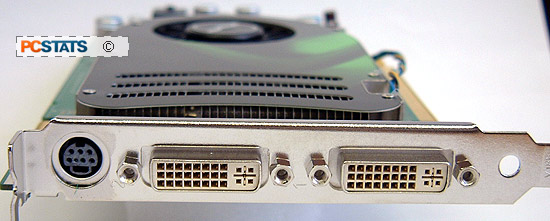 nVidia built the 'G84' GeForce 8600GTS core on Taiwan Semiconductors' 80nm manufacturing process, down from 90nm for the last generation mainstream GPU. The nVidia G84 core has 289 million transistors, and according to nVIDIA documents a maximum power draw of 71W. That puts the Geforce 8600GTS a hair below what a standard PCI Express x16 bus can provide (75W). To be on the safe side the GeForce
8600GTS has a six pin PCI Express power connector to accommodate the differences from one motherboard to the next.
nVidia built the 'G84' GeForce 8600GTS core on Taiwan Semiconductors' 80nm manufacturing process, down from 90nm for the last generation mainstream GPU. The nVidia G84 core has 289 million transistors, and according to nVIDIA documents a maximum power draw of 71W. That puts the Geforce 8600GTS a hair below what a standard PCI Express x16 bus can provide (75W). To be on the safe side the GeForce
8600GTS has a six pin PCI Express power connector to accommodate the differences from one motherboard to the next.
The clock speed of the nVidia GeForce 8600GTS is set at 675 MHz, while the stream processors hum along at 1.45
GHz. The nVidia G84 core only comes equipped with 32 stream processors as opposed to 96/128 with the nVidia G80 core.
The memory runs at a flat 2 GHz, yet with the GeForce 8600GTS the memory bus width is only 128 bits. That translates into a slight memory bandwidth limitation, particularly at higher resolutions or with visual effects like AntiAliasing enabled. Maximum memory size is supposed to be 256MB for all G84 based videocards.
While the G84 core carries onward with nVidia's current thinking of how a graphics processor should be built, there are a few notable changes from the G80. Gone are the hard coded Vertex and pixel shaders, they've been replaced with a more flexible Stream Processor (or unified shader) that
calculates both types of data. The Stream Processors runs at 1.45 GHz incidently. Traditional core clock speeds as we know it are dead, as several internal processors are running at different speeds.
 It's important to note that the GeForce 8600GT only has 32 stream processors
while the sightly better GeForce 8800GTS model has 96 and the 8800GTX 128. If
you remember, 16 stream processors equals one thread processor, so there are only two in the nVidia G84 core.
It's important to note that the GeForce 8600GT only has 32 stream processors
while the sightly better GeForce 8800GTS model has 96 and the 8800GTX 128. If
you remember, 16 stream processors equals one thread processor, so there are only two in the nVidia G84 core.
Each Thread Processor has two groups of eight Stream Processors, and each group talks to an
exclusive texture address filter unit as well as well as being connected to the
shared L1 cache. When more memory is needed, the Thread Processor connects to
the crossbar memory controller. nVIDIA's crossbar memory controller is broken up
into two 64 bit chunks for a total bus width of 128 bits.
By moving the GPU towards a threaded design, the nvidia G84 is much more like
a processor than any graphics core of the past. Any type of data - be it pixel,
vertex, or geometry shader can be processed within the Stream Processor. This
allows load balancing to occur between the various tasks.
PureVideo HD:
As for miscellaneous core technologies, by default the GeForce 8600GTS
supports HDCP over both DVI and HDMI although the latter connector is up to the
manufacturers discretion to implement. The GeForce 8600GT model may or may not have
HDCP support, that is up to the individual manufacturers.
With the release of the GeForce 8600GTS core, nVIDIA is also updating its
PureVideo technology. Dubbed "PureVideo HD" the videocard can now handle the
entire decoding processor of HD-DVD and Blu-Ray movies. According to nVIDIA 100%
of high definition video decoding can be off loaded onto the videocard at speeds
of up to 40Mb/s. Nice.
As it is PureVideo HD will be of benefit to Blu-Ray/HD-DVD type movies only,
and does not boost WMV9 playback at this time. That means high definition videos using the
Microsoft standard will only be accelerated to previous PureVideo levels.

Examining CPU Load with PureVideo
To test PureVideo's High Definition accelerating
capabilities on the Foxconn 8600GTS-256, PCSTATS will play back a video downloaded from
Microsoft's WMV HD Content Showcase through Windows Media
Player 10. "The Discoverers" (IMAX) video is available in both 720P and 1080P
formats. AMD processor utilization will be monitored via Task Manager.

When running the 720P version of the Discoverers video, CPU usage
hovered between 16-21%. It's amazing to see how quickly CPU utilization has
dropped when playing high definition videos.

The 1080P version of the Discoverers video uses even less of the
processor than the 720P video. Amazingly, there is definitely plenty of CPU
resources for whatever you want to run in the background.
Up next PCSTATS will try its hand at overclocking this Foxconn videocard.
